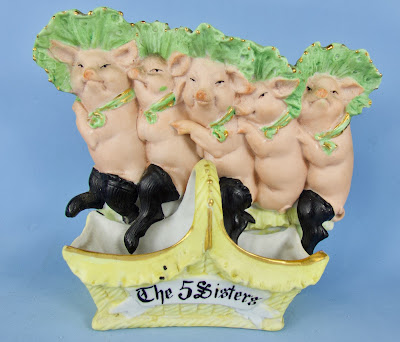Do a search for "Barrison" on this blog, and you will find a number of posts regarding the 5 Barrison Sisters, those voluptuous blond Danish-American siblings whose naughty bawdy vaudeville act briefly brought them fame, fortune, and notoriety in the 1890s. German porcelain companies were quick to cash in on the Barrison's scandalous stardom, producing a variety of bisque figurines and novelties based on the infamous five. These prancing piggies are probably the most unusual tribute (?) I have seen to the Barrisons. Their frilly green bonnets are similar to the girlish outfits often donned by the sisters in acts that mixed innocent antics with sexual double entendres. And the sisters were never shy on stage about exposing their black stocking-clad legs. Plus the caption "The 5 Sisters" emblazoned across the basket is pretty much a giveaway (the "Barrison" was no doubt left out because of copyright concerns. German manufacturers were more than willing to be "inspired" by the Barrisons, but a lot less enthusiastic about paying them any royalties). Out of excellent bisque and beautifully modeled, this frisky fairing is 5.5 inches wide and 5 inches high. Underneath it is stamped in black, "Made in Germany."
One wonders whether this is a comment on the sisters' sometimes tarnished reputations (or the fact that the sisters liked to ham it up onstage) or simply combining the Barrisons' popularity with another fad of the period, pink pig fairings. Fairings were small inexpensive porcelain pieces, often featuring comical or satirical themes, given as prizes or sold as souvenirs at fairs from the mid-1800s through the early 1900s. Fairings were made in Germany by a number of companies. Also in Germany, the pig is a sign of good luck and prosperity. A person who is lucky will say "Ich habe schwein gehabt" (I have had pig). Postcards and other empherma of the period featured glücksschweinchen (good luck pigs), often carrying a four leaf clover or leaping through a horseshoe. It was traditional to give gifts of peppermint or marzipan glücksschweinchen at Christmas and New Years. There is an entire genre of bisque and china fairings featuring pink pigs engaged in typically human activities, such as driving a car or proudly pushing a piglet in a pram. Other fairings focused on the pig as a harbinger of good luck and wealth, such as piggies perched in a purse or peeking out of a money bag. So this figurine may not so much be an editorial comment on the Barrisons as much as some German porcelain company designer telling his boss, "Hey, people are crazy about those Barrison Sisters and people just love pink pigs. So if we can combine them, we will have a guaranteed hit on our hands!"



Absolutely brillant!
ReplyDelete